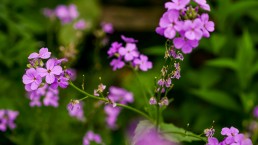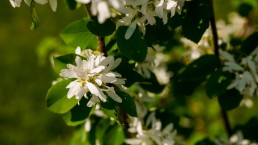Friend, Foe, or Phlox
Three years ago, a common wildflower almost killed me. Three years ago, the same common wildflower saved my life.
Today on my run I felt the telltale signs: vertigo, nausea, hives creeping up my arms and legs, a burning sensation in my throat. I wasn’t surprised when I rounded a cliff and saw her sticking her straight stalk and vibrant blooms up through the sedge and clover. Wild phlox. P. paniculate, one of the 65 members of the Polemoniaceae family. If you gave a kid a box of paints and asked them to decorate the forest, what you would get is phlox: huge neon splashes of purple, pink, pearly white, and red stochastically sprawled across the landscape. They are bright as phosphines burned into your retina after staring at the sun. And their perfume is sweet, powdery, bordering on synthetic. It reminds me of the floral perfumes young girls would wear in high school, to mask the animal funk of their pheromones.
I’ve always been allergic to Phlox. It runs in the family. My dad’s eyes water and he starts to sneeze the day they bloom. And like clockwork, I’m usually right beside him, wheezing and steering clear of the beautiful wildflowers that others pick to accentuate their foraged bouquets. However, three years ago my allergic immune disorder had been especially inflamed. Courses in antihistamines, steroids, and experimental drugs treatments had all proved completely ineffective. And I’d recently moved into a two-hundred-year-old farm house deep in the mountains, unknowingly in the middle of a huge patch of phlox.
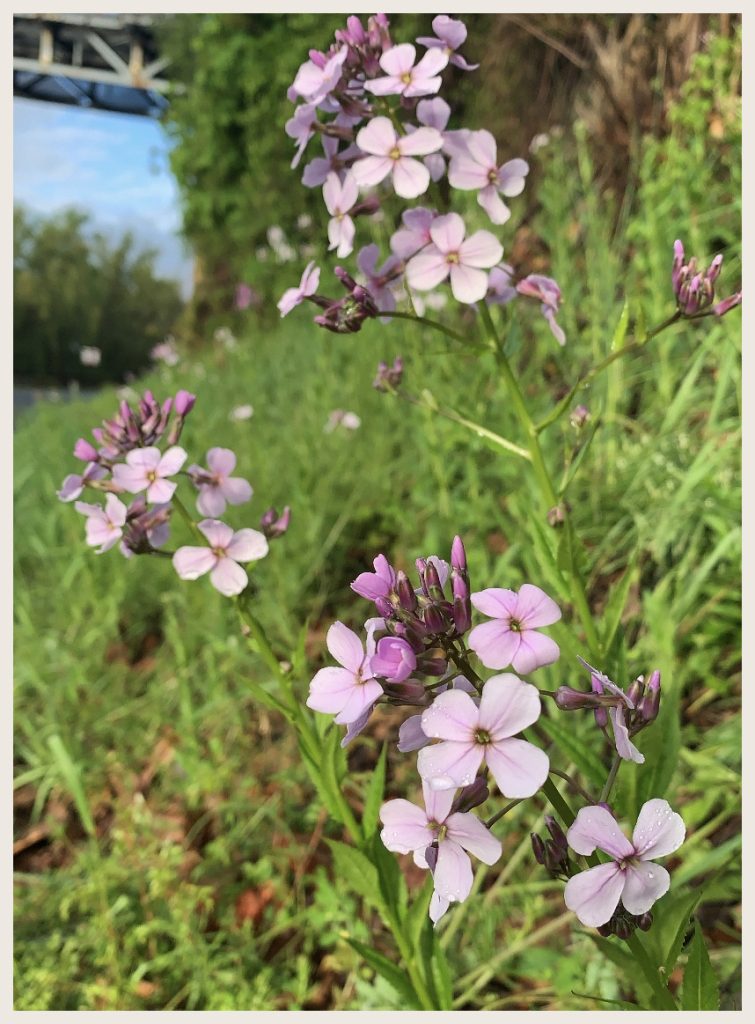
I was very busy so I didn’t pay attention to when it first began. I’d been ghost writing a young adult chapter book a month for the last seven months while researching and finishing my own novel. I’d been juggling cascading health issues, travel, and an unhealthy relationship. So, when I first sneezed, I didn’t think much of it. I walked past a magenta bundle of phlox on my walk home from my favorite coffee shop. “Hello, you beautiful little demons.” I thought almost affectionately. But the truth was, even though I’d always been deeply tied to plants and local ecology, the fast-paced emotionally draining nature of my life had given me vegetal myopia. I was always having animal encounters, but my plant encounters had blurred and begun to fade into the background.
Two days into phlox season something was different. This was not my typical reaction. I was wheezing, but the reaction was deeper than normal asthma. I felt like I was at altitude, a serious runner who suddenly could hardly scale a flight of stairs. I turned beet red from head to foot and started to pee blood. I couldn’t swallow and my kidneys ached. People with long-term health issues will understand the term treatment fatigue. I’d been in the hospital so many times, and been subjected to so many failed treatments, that a stubborn part of me kicked in hard. I would not go to the hospital unless I absolutely had to. Phlox season would pass. I would get through it. Drink tons of water. Shut the open windows. Focus on work. Hide the seriousness of this episode from friends and family. But three days in I entered another realm entirely. I couldn’t move or breathe. I developed a fever, something that can happen when your immune system is thoroughly freaked out. My eyes swelled shut. I started to hammer Benadryl, hoping it would at least blunt the worst of the symptoms.
I started to live in my huge living room, once an old bar in the carriage inn turned house, crawling around my stacks of books blindly, unable to write or read or even sit still. I’m not sure how it happened, but I found myself listening to hundreds of hours of herbal podcasts, lore about local plants and cures, and interviews with ethnobotanists. Unable to sustain reading, I blinked blearily through my collection of wildflower and local plant identification books, tracing the illustrations of phlox with a hive-covered finger. “What am I supposed to be doing?” The Phlox had forced me to sit still enough to realize that I had to change my life. Strangely, I’d strayed off the “path”, by staying too firmly on the path. As a child I ate dirt, kept notebooks full of drawings of my favorite plants and mushrooms, and bushwacked through the forest. But driven by financial need and a narrative I didn’t own, I’d been moving at a pace not suited to the plants and not suited to my own body.
In other cultures, still more attuned to the wisdom of plants, it is common to do plant meditations or work by ingesting a small amount and asking questions. Vegetelistas in South America will ask for plant dreams. But in our fast-paced culture, we don’t often go to plants and ask for medicine. Sometimes the message has to get loud. Phlox realized I was never going to show up on my own. So, she decided to come to meet me. And dream through me. Finally, on day six, ready to admit myself to the hospital, I dragged myself outside, wearing a kerchief around my face and drapes of clothing to protect my skin from the wafting pollen. I hobbled down the road to where she was blooming in a technicolor patch. “What do I need to do? What do I need to do next?”
The answer came immediately. And it came in a tumble of technicolored voices. It’s time to move at the speed of plants. It’s time to study us. To devote yourself to us. I dragged myself back inside and signed up for every local class on herbalism and plant identification walk. I gathered all my books on ecology, plants, herbalism, and trees, and ordered more. Much to my partner at the time’s consternation, I turned my living room into a compost heap of books and pressed flowers and notebooks spread across the floor like fallen leaves. Within a month I was doing an apprenticeship with a famous herbalist (an experience that was controversial and wild and perhaps someday deserves its own essay). And within a month I was healing my own health issues with tinctures and teas I had made myself. Deathly allergic to most antibiotics, I suddenly had another method of treating small infections. A year later, diagnosed with acute kidney failure, I tapped into the plants before beginning a medical intervention. What do I need to do next? I asked, this time more confidently. And they helped me, showing me what to eat and brew and do. When I managed to correct my kidney numbers in the course of the week my doctors were stunned.
When I look back on my life, I can finally see that the phlox saved me. They brought me back into an intimate collaborative relationship with plants. They reintroduced me to a speed of life, rooted and seasonal, that was much better suited to my own tricky body. They were bright and showy and insistent enough that they caught my attention. My deep, undivided somatic attention. And eventually they guided me to the tools to deal with their own wily medicine: strong nettle infusions during allergy season. They were an initiation, squeezing me until I burst open, flower-like, into an expanded vegetal awareness. I’ll never forget day seven of phlox season when I found that I could breathe again. I walked out my front door to see that my new peony bush had recently produced a salmon-pink bloom. And below her crown-vetch was creating little purple fairy crowns. Cleavers bordered the walkway down to the road. Poison ivy embraced the old oak. Mushrooms bubbled up from below the porch. All that year I’d felt alone, trapped inside a draining relationship, living far away from towns and friends, working so hard I didn’t have much time to relax. But suddenly the plants arrived en masse.
“We’ve always been here. And we always want to help.” The phlox twinkled across the road, her color already fading, making way for the orange of day lily season. “Remember to remember us. To greet us. That is the medicine”, she said. “You must know that you are never alone.”
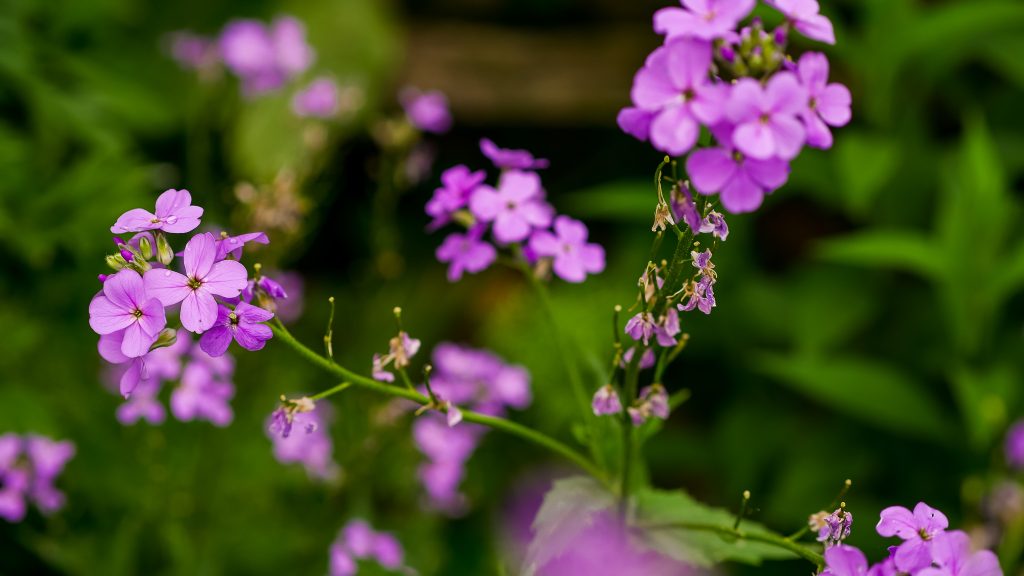
Note: The photos featured in this blog are of plants from the family “Brassicaceae” and not “Polemoniaceae” which is true Phlox. While both are very similar, true Phlox has five petals and five stamens and plants from the Brassicaceae family (Dame’s Rocket) have four petals, and 6 stamens.
First Photo provided by Sophie Strand
Final Photo provided by Serena mor
Preparing for Allergy Season
Spring is Almost Here!
Now is the perfect time to get a jump-start on your seasonal allergies! Stinging Nettle season will be soon upon us and we can make great use of this amazing herb and some honey from our own cupboards. First, some information on allergies, the herbs and nutritional supplements to aid allergy sufferers, tincture formulas and nettle soup recipes. For more information on Stinging Nettle, we’ll be posting a Materia medica soon!.
The Gut and Allergy Connection
All of the symptoms associated with allergies are signs of inflammation: redness, swelling, and itching. To help get rid of allergies, you have to get rid of inflammation and hyper-reactivity. The place to start is in your gut.
One of the major jobs of your digestive system is to provide an interface between the external world (foods, allergens, bacteria, etc.) and your blood stream. It does this in the stomach by using natural digestive acids to break down potentially allergenic proteins and in the intestines via a layer of barrier cells that prevents these proteins from getting into your blood stream. You also have a whole host of special bacteria in your gut, as well as immune cells, whose job it is to break down and get rid of proteins and other molecules that can cause you to get sensitized to them, leading to gut – and systemic – inflammation.
How to restore your gut:
- Clean Up Your Diet – Remember to eat lots of fresh vegetables, fruits, seed and nuts. Eliminate sugar, soda, preservatives, additives, dyes and other non-food junk, and drastically decrease dairy intake (yes, if you want your allergies to go away forever, you will have to do this – sorry). Part of cleaning up your diet is to eat foods with as few chemicals and additives as possible. I highly recommend buying organic or visiting your local farmers market.
- Heal Your Gut
- This is done with an Elimination Diet. An elimination diet is 2 weeks of eating a simple diet from which you have removed the most common food triggers including gluten, sugar, dairy, eggs, soy, coffee, soda, and artificial ingredients – as well as anything you typically crave (i.e., sugar, carbs, salty snacks).
- If you have constipation, you’ll want to deal with this now. Get plenty of fiber in your diet and drink ample water, too. Supplements such as flax seed, psyllium, and magnesium citrate are safe for most people to take daily. For kids, slippery elm, which tastes like maple syrup, may be used, 1-2 tsp daily in oatmeal or a smoothie. The goal is 1 healthy bowel movement every day.
- After 2 weeks on the Elimination Diet, start taking a good quality digestive enzyme product (you can give these to kids over 4 yrs, too). This is safe for pregnant and breastfeeding women, too.
- After another week, add in a good quality probiotic. Also safe for pregnant and breastfeeding women, and for kids.
- The following supplements can now be taken for about a month (up to 6 months) to help to heal the intestinal lining: Tumeric, Aloe Vera, and Marshmallow root; (these are fine for children) are some of the most effective herbs for healing the gut lining.
- Zinc: 5-10 mg/day for children 4-7 years, 10-20 mg/day for children to age 12, 25-40 mg/day for older children and adults
- An antioxidant supplement containing vitamins A and carotenoids, C, E, and selenium. These are often found in a multivitamin. Pregnant women should get these from their prenatal vitamin only.
- Fish oil: Personally, I have taken daily for years, love it! For kids you can put the oil into smoothies. Fish oil is important for general health in pregnancy and breastfeeding, too.
- Please visit your doctor when necessary!
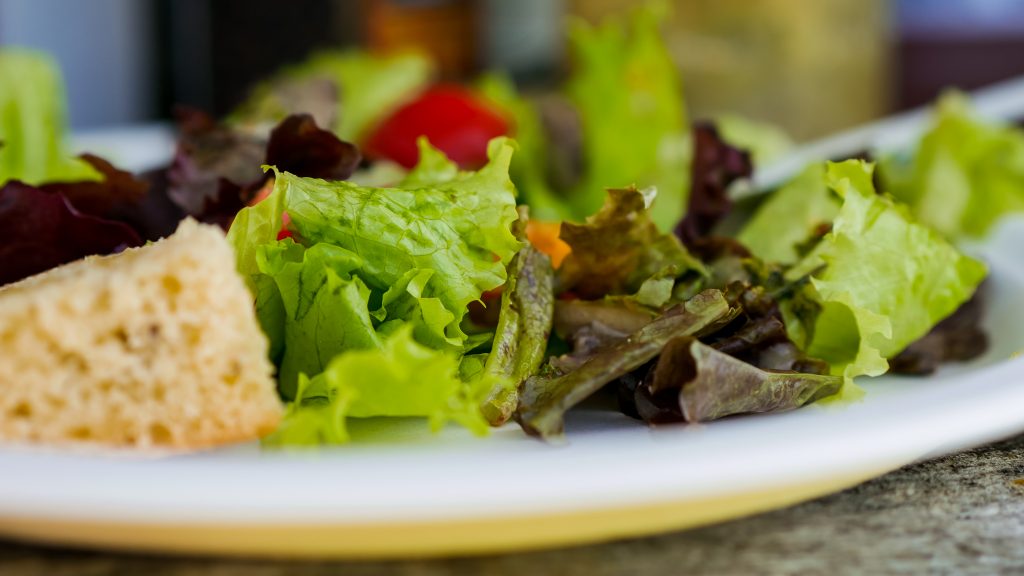
Detox The Liver
The liver removes many of the body’s major toxins and affects allergies. Martin Healy says that key ways to boost your liver function include cutting out alcohol, smoking, caffeine and embarking on a detox program.
A glass of water containing freshly squeezed lemon each morning will help. Antioxidants and vitamins found in fresh fruits and vegetables will reduce liver inflammation and boost immune function, while foods like brussels sprouts will increase the activity of important liver enzymes.
Herbs and Nutritional Supplements for Seasonal Allergies
These herbs and nutritional supplements are best taken on a daily basis. Taking them before allergy season even starts, can prevent symptoms altogether. They can also be used as needed.
- Stinging Nettle: Nettles are used as spring tonics and a general detoxifying remedy. In some cases of rheumatism and arthritis, nettles can be astoundingly successful. In childhood eczema nettles are a specific remedy and are beneficial in all the varieties of this condition especially in nervous eczema.
Nettles in high doses can have amazing results for allergy sufferers. It has been used for centuries to treat allergy symptoms – particularly hay fever – which is the most common allergy problem. It contains biologically active compounds that reduce inflammation. Dr. Andrew Wiel M.D. author of Natural Health/Natural Medicine says he knows of nothing more effective than nettle for allergy relief. This statement is backed up by studies at the National College of Naturopathic Medicine in Portland, Oregon. Decongestants, antihistamines, allergy shots and even prescription medications such as Allegra and Claritin treat only the symptoms of allergies and tend to lose effectiveness over a period of time. They can also cause drowsiness, dry sinuses, insomnia and high blood pressure. Nettle has none of these side effects. It can be used on a regular basis and has an impressive number of other benefits most notably as a treatment for prostate enlargement. Nettle is easily available in tea and tincture form, and also can be eaten like spinach in the spring, made into soups and smoothies. Nettles are prized for being highly nutritional.
- Raw Local Honey: Raw honey is great, but raw local honey is even better! Raw local honey contains pollen that is specific to your area and therefore can really help those local seasonal allergies. Taking a spoonful of raw honey once or twice a day is a great help. It is also advised to begin taking local honey a few months prior to the allergy season; this gets the pollen introduced into the body and gradually builds up the body’s tolerance to seasonal allergies. Honey is not recommended for babies under 12 months, due to infant botulism.
- Vitamin C: To assist with a malfunctioning immune system try lemon water and orange water (not juice – no sugar), cultured vegetables and strawberries.
- Quercetin: 500 mg daily (half that for kids). Quercetin is a plant pigment found in many common herbs and foods, and a very reliable anti-inflammatory nutritional supplement. It helps with gut repair, boosts the immunity in your mucus membranes reducing reactivity to seasonal allergens, and also helps reduce food allergies. There is conflicting data on whether it is safe in pregnancy, therefore I would not recommend it for those who are pregnant.
- Zinc: Take an age appropriate dose daily.
- Please visit your doctor when necessary!
Traditional Allergy Tincture Blend
- Nettle (Urtica dioica, spring tops) 0.30 ml
- Astragalus (Astragalus membranaceus, root) 0.25 ml
- Reishi (Ganoderma lucidum, thallus) 0.14 ml
- Schisandra (Schisandra chinensis, fruit) 0.14 ml
- Southern Prickly Ash (Zanthoxylum clava-herculis, bark) 0.07 ml
Keep an eye out for another blog full of Stinging Nettle Recipes soon!

